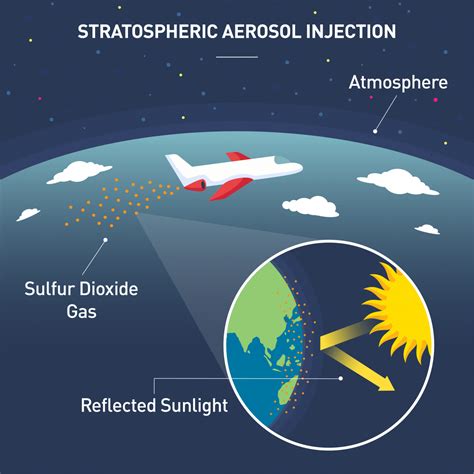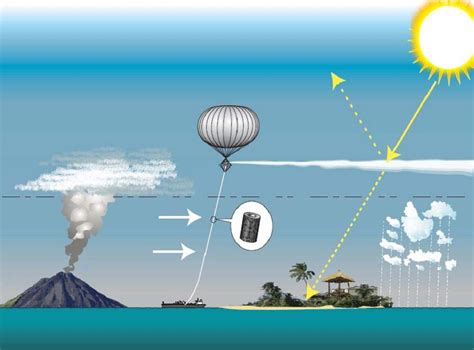Aerosol Injection

In the realm of climate engineering, a controversial yet increasingly discussed topic is the idea of aerosol injection, a proposed method to combat the impacts of climate change. This article delves into the complexities of this potential geoengineering solution, exploring its mechanisms, potential benefits, and the myriad of challenges it presents.
Understanding Aerosol Injection

Aerosol injection, also known as solar radiation management (SRM), is a geoengineering technique aimed at reducing the amount of sunlight reaching the Earth’s surface. The process involves releasing small reflective particles, known as aerosols, into the stratosphere, where they can scatter and reflect sunlight back into space.
The concept draws inspiration from natural phenomena, such as volcanic eruptions, which can release massive amounts of sulfur dioxide into the atmosphere, leading to a temporary cooling effect. Scientists propose that by mimicking this process, we could potentially offset some of the warming caused by greenhouse gas emissions.
How Does Aerosol Injection Work?
The proposed method involves the use of specialized aircraft or balloons to deliver aerosols into the stratosphere, approximately 10-50 kilometers above the Earth’s surface. These aerosols can be made from various materials, with sulfur dioxide and calcium carbonate being the most commonly discussed options.
Once released, the aerosols would remain suspended in the stratosphere for several months, potentially reflecting a small percentage of incoming sunlight. Scientists estimate that a reduction of just a few percent could offset the warming effect of increased greenhouse gases.
| Aerosol Type | Potential Impact |
|---|---|
| Sulfur Dioxide | High reflectivity, but potential for ozone depletion |
| Calcium Carbonate | Lower reflectivity, but more environmentally friendly |

Potential Benefits of Aerosol Injection

Advocates of aerosol injection argue that this method could provide a rapid and cost-effective solution to mitigate some of the most severe impacts of climate change. Here are some of the potential benefits:
Rapid Cooling Effect
Aerosol injection has the potential to rapidly cool the Earth’s surface, providing a temporary respite from rising temperatures. This could be particularly beneficial in the face of extreme weather events, offering a chance to buy time for other mitigation and adaptation strategies to take effect.
Cost-Effective Solution
Compared to other geoengineering techniques, aerosol injection is relatively inexpensive. The materials required are readily available, and the technology needed to deliver the aerosols is already in use in various industries. This makes it an attractive option for governments and organizations with limited resources.
Flexibility and Control
Aerosol injection allows for a high degree of control and flexibility. The amount of aerosols released can be adjusted based on the desired cooling effect, and the process can be halted or reversed relatively quickly if necessary. This control provides an added layer of security and the ability to respond to changing climate conditions.
Challenges and Ethical Considerations
Despite the potential benefits, aerosol injection faces significant challenges and raises ethical dilemmas that must be carefully considered.
Environmental Impact
One of the primary concerns is the potential environmental impact of aerosol injection. While the process may reduce surface temperatures, it could have unintended consequences on weather patterns, precipitation, and the Earth’s ecosystems. The long-term effects on biodiversity and the water cycle are still largely unknown.
Additionally, the use of certain aerosols, such as sulfur dioxide, could lead to ozone depletion and the formation of harmful aerosols, which may have detrimental effects on human health and the environment.
Political and Ethical Dilemmas
Aerosol injection raises complex political and ethical questions. Who would control the deployment of aerosols, and how would global agreements be reached? What if one country’s decision to inject aerosols affects the climate in another region? These questions highlight the need for international cooperation and governance in the face of such powerful technologies.
Masking the Problem
Another concern is that aerosol injection could be seen as a quick fix, distracting from the urgent need to reduce greenhouse gas emissions. Critics argue that it may provide a false sense of security, allowing countries to continue their reliance on fossil fuels and delay necessary transitions to cleaner energy sources.
Real-World Applications and Research
While aerosol injection remains a theoretical concept, there have been some efforts to explore its feasibility and potential impact. Here are a few notable examples:
The Stratospheric Particle Injection for Climate Engineering (SPICE) Project
SPICE was a UK-based research project aimed at investigating the technical and social aspects of aerosol injection. The project included a proposed field test to release a small amount of water vapor into the stratosphere, but public opposition and ethical concerns led to the cancellation of the test.
Harvard’s Stratospheric Controlled Perturbation Experiment (SCoPEx)
SCoPEx is a proposed experiment by Harvard University to study the effects of aerosol injection. The project involves the release of calcium carbonate particles from a high-altitude balloon to measure their scattering effect and potential impact on the atmosphere. The experiment is still in the planning stages.
Global Modeling Studies
Scientists have conducted various global modeling studies to simulate the potential effects of aerosol injection. These models help researchers understand the possible climate responses, regional impacts, and the overall effectiveness of the technique. While these studies provide valuable insights, they are limited by the complexity of the Earth’s climate system.
Future Implications and Conclusion

Aerosol injection presents a fascinating yet controversial approach to addressing climate change. While it offers a potential temporary solution to rising temperatures, it is not without its challenges and risks. The decision to pursue such a technique requires careful consideration of its potential impacts, both intended and unintended.
As we continue to explore the possibilities of geoengineering, it is essential to maintain an open dialogue, conduct rigorous research, and engage in international cooperation. The future of our planet may depend on our ability to make informed decisions and take responsible actions.
What are some alternative geoengineering techniques being explored?
+Alternative geoengineering techniques include ocean fertilization, which aims to enhance carbon sequestration by stimulating phytoplankton growth, and afforestation, the large-scale planting of trees to absorb carbon dioxide. These methods, along with others, are being studied for their potential to mitigate climate change.
How do scientists ensure the safety of geoengineering experiments?
+Scientists follow rigorous protocols and ethical guidelines to ensure the safety of geoengineering experiments. This includes extensive modeling, risk assessments, and public engagement to address concerns and ensure transparency. Safety measures are crucial to prevent unintended consequences.
Can aerosol injection be a permanent solution to climate change?
+Aerosol injection is not intended as a permanent solution but rather a temporary measure to buy time for other mitigation strategies. Its effectiveness is limited, and it cannot address the root cause of climate change, which is the accumulation of greenhouse gases. A long-term sustainable solution requires a reduction in emissions.



